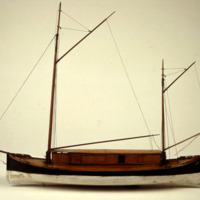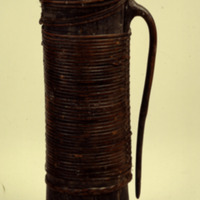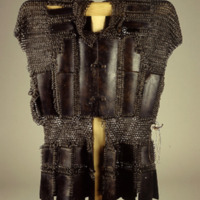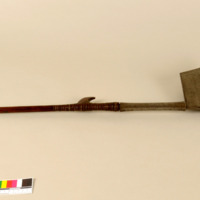Visayan Hat
Text
Basketry hat in a flattened hemispherical shape and finished off with a silver ornament. It consists of a zigzag braided plant fiber support lined internally and externally with a different fabric. Braided fiber forming a checkered pattern. The inner lining is sewn to the support with threads, in concentric semicircular stitches. The outer lining is waterproofed with pitch, which gives it a dark color. Flange formed by a bundle of fibers formed with other types of fibers. Upper part topped by a circular silver ornament with the edge adorned with a carved vegetal border with a pinnacular appendage in the center. Inside, it would have a rim to support the acabeza, which has been lost. The fibers most used in the manufacture of hats were Buutan, Burí (Coryphaum braculifera) and nipa (Nipa fruticans).
Used as a badge of dignity or rank among men of Christian groups.
Around 1840 it was adopted as uniforms for native army troops.
During the 19th century, its use was widespread throughout the Philippine Archipelago.
Observations: Broken outer lining, missing a large fragment and several small ones. In the part bottom of the wing has two deformations, one on each side, intentionally made to hang it up.
Inside there is no support to hang the head, there are remains of the threads of the sewing. Superior decoration in sulfated silver.
Restored in 1991 at the Institute for the Conservation and Restoration of Cultural Assets "Madrid"
Spanish version:
Sombrero de cestería en forma semiesférica achatada y rematado por un adorno de plata. Consta de un soporte de fibra vegetal trenzada en zigzag forrado interna y externamente por un tejido diferente. Fibra trenzada formando un ajedrezado. El forro interno está cosido al soporte con hilos, en pasadas semicirculares concéntricas. El forro esterior está impermeabilizado con brea, lo que le da un color oscuro.
Reborde formado por un haz de fibras formado con otro tipo de fibras. Parte superior rematada por un adorno de plata circular con el borde adornado con una cenefa vegetal labrada con un apéndice pinacular en el centro.
En el interior llevaría un reborde para apoyar la acbeza, que se ha perdido.
Las fibras más usadas en la fabricación de sombreros eran Buutan, Burí (Coryphaum braculífera) y la hipa (Nipa fruticans).
Usado como distintivo de dignidad o de rango entre hombres de los grupos cristianos.
Hacia 1840 fue adoptado como uniformes para tropas nativas del ejército.
Durante el siglo XIX su uso fue muy difundido en todo el Archipiélago Filipino .
Share this



